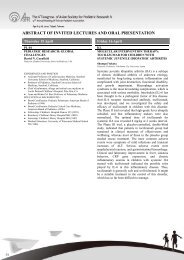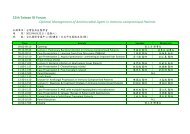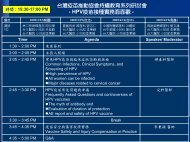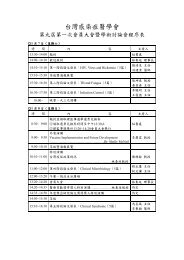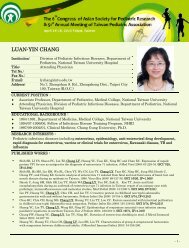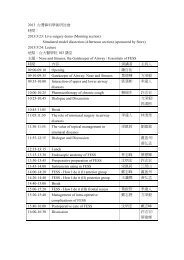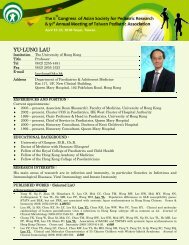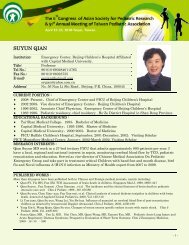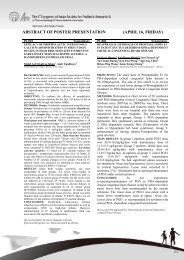ABSTRACT OF POSTER PRESENTATION (APRIL 17, SATURDAY)
ABSTRACT OF POSTER PRESENTATION (APRIL 17, SATURDAY)
ABSTRACT OF POSTER PRESENTATION (APRIL 17, SATURDAY)
You also want an ePaper? Increase the reach of your titles
YUMPU automatically turns print PDFs into web optimized ePapers that Google loves.
P2-093 Gastroenterology P2-094 GastroenterologyARE CONTAMINATED EGGS THE MAINSOURCE <strong>OF</strong> FOODBORNE SALMONELLOSISIN INFANTS?ASSOCIATION <strong>OF</strong> INTERLEUKIN-18 GENEPOLYMORPHISMS WITH SUSCEPTIBILITY TOBILIARY ATRESIAKing-Jun Koh 1 , Lung-Huang Lin 1 , Min-Hsuan Hung 1 ,Yu-Ti Fang 2 , Qing-Dong Ling 2Department of Pediatrics, Cathay General Hospital, Taipei, Taiwan 1Cell Biology Lab, Cathay Medical Research Institute, Cathay GeneralHospital, Taipei, Taiwan 2OBJECTIVES: Salmonella species are recognized as majorzoonotic pathogens for animals and humans. In manycountries, Salmonella is the leading cause of foodborneoutbreaks and infections. The foodborne disease is animportant health and economic issue that burdens the worldover. Epidemiological investigations in Hungary, U.K, U.S,and Germany confirmed that the food most associated withincreased foodborne Salmonellosis was from the eggs. Themain cause of this epidemic is the infections due to S. entericasubsp. enterica serovar Enteritidis (S. Enteritidis), a serotypeprevalent in poultry, particularly in eggs. In Taiwan, peoplepurchase eggs from traditional retail market or supermarket.Here, we want to know the situation of Salmonellacontamination in the washed, commercially processed eggsand the eggs in the traditional retail market.METHODS: From Aug. 2008 to Sep. 2009, we collected eggsfrom chicken layer farms, traditional retail markets,supermarkets and home of the infants who were infected bySalmonella. All of the eggs were sent back to laboratory atroom temperature and exam immediately. The egg shells wereswabbed by sterile swab with normal saline. Then the swabswere streaked onto the plate of Xylose-lysine-desoxycholate(XLD) agar and incubator at 35℃. Suspect Salmonellacolonies were confirmed by serotyping at laboratory usingCenters for Disease Control methods.MAIN RESULTS: There were totally 284 eggs collected. 50eggs were processed eggs which were bought at supermarkets,4 eggs were collect from patients’ home, 160 eggs were fromtraditional retail market and 70 eggs were from the chickenlayer farms. There were some other colonies but noSalmonella species were isolated in this study.CONCLUSION: Contamination of eggs with Salmonella canoccur in several ways: egg shells may be contaminated byfaeces; cleaning procedures maybe improper; the interior ofthe egg may be contaminated by the shell being cracked.Contamination may also be internal, prior to the shellformation through trans-ovarian transmission. An earliersurvey in Taiwan showed no Salmonella detected in eggs andour study revealed the same results. Thus, local Salmonellaenterocolitis infection may not be due to polluted eggs.Contaminated equipment in food processing factory andinfected food handlers may be the main cause of foodproduct-related outbreaks. Although it is not a recentlyrecognized phenomenon and remains controversial, a foodhandler is capable of transmitting Salmonella if acutely ill oras an asymptomatic carrier. More study are needed to clarifywhether the source is from the human carrier or from otherfood contamination.Shun-Feng Lin 1 , Hung-Chang Lee 1, 2 , MD, Tzu-YangChang 3 , PhD, Chun-Yan Yeung 1,4 , MD, Wai-Tao Chan 1 ,MD, Chuen-Bin Jiang 1 , MD, Hui-Wen Chan 3 , MS,Wei-Fang Chen 3 , MS, Hsin-Fu Liu 3 , PhD, Marie Lin 3 , MD,Yann-Jinn Lee 1, 2, 3 , MD, MSDepartments of 1 Pediatrics and 3 Medical Research, Mackay Memorial Hospital,Taipei, Taiwan; 2 Department of Pediatrics, Taipei Medical University, Taipei,Taiwan; 4 Mackay Medicine, Nursing and Management College, Taipei, TaiwanOBJECTIVE: Biliary atresia (BA) is a destructiveinflammatory obliterative cholangiopathy of neonatesthat affects both intrahepatic and extrahepatic bile ducts.Although the etiology is unknown, immunologicallymediated injury of bile ducts triggered byas-yet-unidentified infectious agents is likely to play acritical role. Interleukin-18 (IL-18) is a proinflammatorycytokine that plays an important role in immune,infectious, and inflammatory diseases due to itsinduction of interferon-γ. In this study we investigatedwhether polymorphisms of the IL-18 gene wereassociated with susceptibility to BA.METHODS: Genomic DNA was extracted from wholeblood samples of 50 Taiwanese children with BA and375 ethnically-matched healthy controls. The IL-18 –607C/A, –137 G/C, and +105 A/C polymorphisms weregenotyped using the TaqMan assay.MAIN RESULTS: No statistically significant differencesin genotype, allele, carrier, and haplotype frequencies ofthese IL-18 gene variants were found between childrenwith BA and healthy controls.CONCLUSION: Our data suggest that the IL-18 genedoes not play a major role in BA predisposition in theTaiwanese children.[Keywords]Foodborne Salmonellosis301



